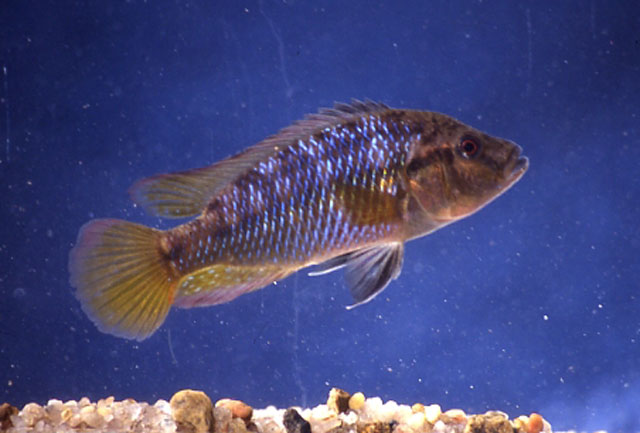| Cichlidae (Cichlids), subfamily: Pseudocrenilabrinae |
| 13 cm TL (male/unsexed); max. reported age: 5 years |
|
benthopelagic; freshwater; pH range: 7; dH range: 12, |
| Africa: from the Orange River system and southern KwaZulu-Natal northwards throughout southern Africa, extending to southern Congo basin tributaries (Ref. 7248, 52193) and lagoons and rivers associated with Lake Malawi, but not the lake itself (Ref. 55954). Also in Lake Rukwa (Ref. 27292). Three subspecies are recognized: Pseudocrenilabrus philander dispersus, Pseudocrenilabrus philander luebberti and Pseudocrenilabrus philander philander. |
|
Dorsal spines (total): 13-16; Dorsal soft rays (total): 9-11; Anal spines: 3-3; Anal soft rays: 7-9. Description: Body stout; mouth small, horizontal (Ref. 52193). Dorsal fin with 13-16 spines and 9-11 soft rays; anal fin with 3 spines and 7-9 soft rays; pectoral fin short and rounded; caudal fin strongly rounded (Ref. 4967, 52193). Lateral line scales 26-31, chest scales not sharply differentiated from body scales (Ref. 4967, 52193). Colouration: Females are light brown with black vertical bars and light yellowish fins (Ref. 52193). Male colours differ with locality; body usually a mesh of iridescent light blue and yellow, with an oblique bar through the eyeand iridescent blue lower jaw; dorsal fin has a red tip, black submarginal band and iridescent blue blocks, pelvics black, caudal and anal fins have iridescent blue and red blocks, anal with orange tip; colours are accentuated during breeding (Ref. 52193). |
| Found in various habitats, from flowing waters to lakes and isolated sinkholes, e.g., Lake Otjikoto, Namibia (see Ref. 27829); usually prefers vegetated zones. It feeds on insects, shrimps and even small fish (Ref. 52193). Breeds from early spring to late summer; males establish and defend a territory, construct a simple cleared nest and attract ripe females; eggs are laid in the nest, fertilized and collected by the female; the female withdraws to a quiet nursery area to brood the eggs, larvae and juveniles until they are able to fend for themselves (Ref. 7248, 52193). Ovophilic, agamous maternal mouthbrooder; no pair-bonding takes place (Ref. 52307). |
|
Least Concern (LC); Date assessed: 28 February 2018 Ref. (130435)
|
| harmless |
Source and more info: www.fishbase.org. For personal, classroom, and other internal use only. Not for publication.

